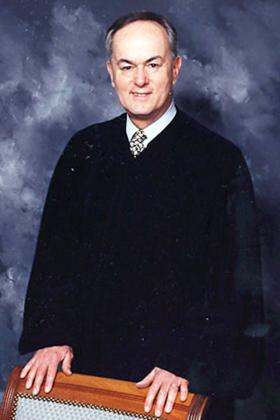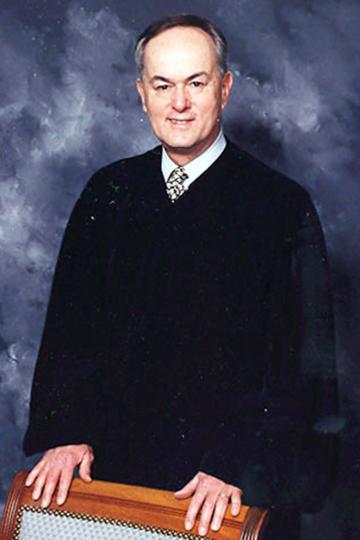

- Term: Oct. 26, 2006 - June 17, 2007
- Status: Retired
Introduction
James R. Zazzali was cut from cloth much like that which gave us Chief Justice Richard Hughes. Both men had careers largely devoted to public service and believed in the power of government to help ordinary people. The “working and the poor” have always been one of Chief Justice Zazzali’s primary concerns, both personally and as an attorney.
After graduating law school in 1962, Jim embarked on a career with the labor movement representing workers and unions in the South, an experience that affected the rest of his life and work. Upon returning to New Jersey, he served as a judicial law clerk, and then as an Assistant Essex County Prosecutor. He and his brother were named General Counsel to the New Jersey Sports and Exposition Authority. In 1981, Governor Brendan Byrne appointed him Attorney General.
Chief Justice Zazzali was the seventh Chief Justice of the Supreme Court under the 1947 Constitution, holding the position for almost a year before mandatory retirement from the bench at age 70. Prior to his appointment as Chief Justice in October of 2006, he served for six years as an Associate Justice. During his time on the Court, he authored nearly 100 majority opinions, including ten as Chief Justice, and also wrote dozens of concurrences and dissents. His opinions - - and his interests - - ranged across a spectrum that included children’s welfare, workers’ rights, corporate liability, and individual property issues. He served with distinction and upheld the highest standards of our Supreme Court.
Personal History
Chief Justice Zazzali was born on June 17, 1937 in Newark, New Jersey. After graduating from Seton Hall Preparatory School, he attended Georgetown College, and graduated from Georgetown Law Center in 1962. Following law school, unlike most of his classmates who went north to the large firms and corporations, he went south to become active in a nascent labor movement. He then returned to New Jersey to clerk for Honorable Lawrence A. Whipple.
From 1965 to 1968, he was an Assistant Essex County Prosecutor, beginning a lifelong friendship with the Essex County Prosecutor, Brendan Byrne, later the 47th Governor of New Jersey. In the Essex Prosecutor’s Office, he rose to the position of Chief of the Appeals Section. After serving as a prosecutor, he remained in Newark, joining his brother in the firm that his father had founded. He also was appointed to the Editorial Board of the New Jersey Law Journal.
In 1981, near the end of his second term, Governor Byrne named him State Attorney General. During his tenure, he embarked on a crusade against sweatshops, protected migrant workers, addressed drug and alcohol abuse among minors, helped raise New Jersey’s drinking age from eighteen to twenty-one and made myriad efforts to address diverse problems in the belief that an Attorney General should not focus only on criminal matters but also should address economic and social justice concerns. He later served as Chairman of the State Commission of Investigation (SCI) where he also expanded its role to address matters concerning the public welfare in addition to its traditional concerns regarding organized crime and political corruption.
In those years, he served as Chairman of the Judicial Labor Relations Task Force, Vice Chair of the Disciplinary Review Board, Vice Chair of the Advisory Committee on Judicial Conduct, and special master to help reform the Essex, Monmouth, and Bergen County jails.
Service on New Jersey Supreme Court
On May 18, 2000, Governor Christine Todd Whitman nominated Chief Justice Zazzali to be an Associate Justice of the New Jersey Supreme Court. He was confirmed by unanimous vote of the State Senate and served six years as an Associate Justice until Governor Jon Corzine nominated him to succeed Deborah T. Poritz as Chief Justice. Chief Justice Zazzali held that position until June 17, 2007, when he reached the mandatory retirement age for members of the New Jersey Judiciary.
Justice Zazzali's appointment as Chief Justice maintained New Jersey's longstanding tradition of a bipartisan judiciary. Ever since the 1947 NJ Constitution, by tradition, Democrats and Republicans are appointed to the Superior Court in equal numbers, and the seven person Supreme Court may not have more than four justices from the same party. This practice helps ensure an independent, nonpartisan, and balanced judiciary.
Although he recognized that his tenure would not be lengthy, he chose not to be a caretaker. Rather, he made intensive efforts, both as a jurist and as the judicial system’s top administrator, that left lasting marks on the New Jersey Judiciary.
Notable Opinions and Judicial Leadership
During his time as Chief Justice, his opinions were noted for upholding the rights of the ordinary citizen, with special concern for children, worker’s rights and individual property rights.
A few examples suffice :
- In L.W. v. Toms River Regional Schs. Bd. of Educ., 189 N.J. 381, 406-07 (2007), Chief Justice Zazzali wrote for a unanimous Court in holding a school district liable under the New Jersey Law Against Discrimination for student-on-student affectional or sexual orientation harassment when the school district “knew or should have known of the harassment but failed to take actions reasonably calculated to end the mistreatment and offensive conduct.” In that seminal decision, N.J. Div. of Youth and Fam. Servs. v. M.M., 189 N.J. 261, 289-90 (2007), he upheld the termination of parental rights if a child’s welfare was endangered due to parent’s inability to shield the child from the other parent’s abusive behavior. In Jerkins v. Anderson, 191 N.J. 285, 289 (2007), he held that that schools have a continued duty of reasonable care to protect children after the school day ended.
- In Iliadis v. Wal-Mart Stores Inc., 191 N.J. 88, 95 (2007), Chief Justice Zazzali upheld the ability of employees who claimed they had been denied rest breaks and forced to work for certain periods without being paid to sue the company in a class action. "Individually, the aggrieved Wal-Mart employees lack the strength in terms of resources and motivation to assert their grievances in court," he wrote for the majority. "Collectively, as a class, they are able to pursue their claims." Id. at 120. In Lozano v. Frank DeLuca Constr., 178 N.J. 513, 518 (2004).
- In what might be regarded as his most noted ruling while Chief Justice, he ruled in Gallenthin Realty Dev., Inc. v. Borough of Paulsboro, 191 N.J. 344, 348 (2007), that the New Jersey Constitution limited the use of the power of eminent domain for redevelopment to “blighted areas” and thus land could not be taken from owners merely because the land was “not fully productive.” Zazzali wrote that “Although community redevelopment is an important municipal power, that authority is not unfettered . . . The New Jersey Constitution does not permit government redevelopment of private property solely because the property is not used in an optimal manner.” Id. at 373. The Gallenthin ruling thus provided significant protection against overly expansive use of eminent domain..
Chief Justice Zazzali not only advanced New Jersey jurisprudence, he also sought to improve the administration of justice. Soon after being sworn in, he visited each of the state’s fifteen vicinages to meet with judges, staff and local bar members. He used those visits to listen to the ideas and concerns of those whose work most directly impacts the public, and he shared his own priorities for the Judiciary. During difficult and politically fraught fiscal times, he was instrumental in obtaining salary increases for judges, whom he feared were leaving public service because of higher salaries in private practice.
He also advocated for diversity within the state judiciary. He met with groups of minority judges and minority attorneys to discuss inclusivity issues on the bench and the need to prepare and appoint both minority and women judges for leadership roles in the court system. In the General Assignment Order for 2007, the four judges that he elevated to the Appellate Division were women.
For Chief Justice Zazzali, building public trust and confidence in the court system was a priority while he led the Court. He gave numerous public addresses in a variety of settings, provided interviews, met with the editorial boards of the state’s news organizations and created a standing Bench, Bar, and Media Committee to promote the public’s understanding of and access to the courts. His concern for children and families, expressed in his opinions, was a catalyst for the creation with the Division of Youth and Family Services (DYFS) to create a joint task force to address the needs of children and parents who are victims of domestic violence.
After his retirement, Zazzali rejoined his firm, Zazzali, Fagella, Nowak, Kleinbaum & Friedman, and also serves as of-counsel to the Gibbons law firm in Newark
The New Jersey Law Journal summed up his career when it called him “the guardian of the little guy."





